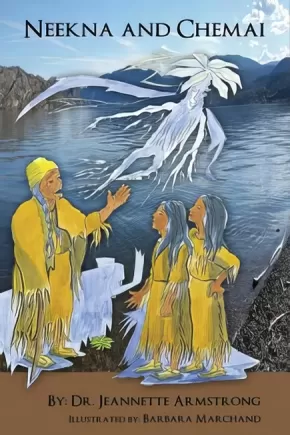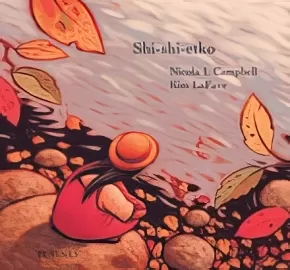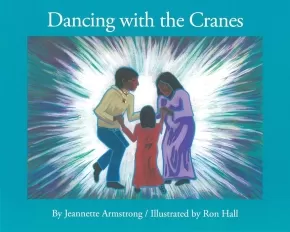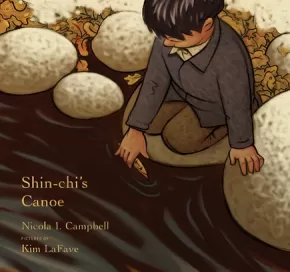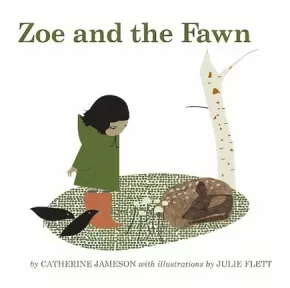
Syilx (Okanagan)
16
-
24
of
24 Results;
Sort By
Go To
of 2
iʔ siwɬkw nkwancinəm k̕əl suliʔ / The Water Sings to Suli?
$15.95
Format:
Paperback
Text Content Territories:
Indigenous Canadian; First Nations; Salish; Interior Salish; Syilx (Okanagan);
ISBN / Barcode: 9781926886671
Synopsis:
Synopsis:
iʔ siwɬkw nkwancinəm k̕əl suliʔ / The Water Sings to Suliʔ is an original story with a universal message, shedding light on the importance of water as a living entity. The story features a young girl named suliʔ, who hears the song of the water calling for her while playing outside. suliʔ ventures out of her yard and into the forest. Along the way she meets an unexpected magic water child. The water child entrusts suliʔ with an important message to share with the world.
Educator & Series Information
Recommended for ages 4 to 6.
Author Harron Hall has written several books for children that incorporate her Indigenous heritage and her deep commitment to protecting the land and water.
Includes words in n'syilxwcn.
This book is part of the Follow the Water series.
Additional Information
54 pages | 8.00" x 8.00"
La pirogue de Shin-chi
$12.95
Artists:
Format:
Paperback
Text Content Territories:
Indigenous Canadian;
ISBN / Barcode: 9782896118076
Synopsis:
Synopsis:
« Au bout du couloir, dans l’aile des petits garçons, Shin-chi était allongé dans son lit mais ne dormait pas. Il tenait précieusement sa petite pirogue dans la main. L’odeur parfumée du cèdre lui rappelait celle de son père. »Quand les Européens sont arrivés en Amérique, ils ont estimé que les Autochtones étaient des peuples non civilisés. Ils les ont chassés de leurs terres traditionnelles et les ont relégués dans des réserves. À la fin des années 1800, les gouvernements ont décidé de coloniser les enfants autochtones, de les forcer à s’adapter au mode de vie européen. Au Canada et aux États-Unis (mais également en Australie et en Nouvelle-Zélande), des lois furent adoptées obligeant les jeunes Autochtones à être éduqués dans des pensionnats autochtones.Dans ces établissements, les enfants apprenaient la culture, la religion et la langue des Européens. On leur donnait un nom européen. On leur enseignait le jardinage, l’agriculture et la menuiserie. On leur interdisait de parler à leurs parents ou à leurs frères et sœurs. Ils n’avaient pas non plus le droit de parler leur langue ni de pratiquer leurs coutumes. Certains enfants n’ont pu retourner chez eux qu’après de nombreuses années passées au pensionnat. D’autres n’y sont jamais retournés. Le Canada a compté environ 130 pensionnats indiens, et quelque 80 000 personnes vivant encore aujourd’hui y ont séjourné.
Educator Information
This book is available in English: Shin-chi's Canoe
Neekna and Chemai
$16.95
Artists:
Format:
Paperback
Text Content Territories:
Indigenous Canadian; First Nations; Salish; Interior Salish; Syilx (Okanagan);
ISBN / Barcode: 9781926886435
Synopsis:
Synopsis:
Neekna and Chemai are two little girls growing up in the Okanagan Valley in the time before European contact. Through these two friends, we learn about the seasonal life patterns of the Okanagan First Peoples. The girls spend time with Great-Grandmother, who tells them about important ceremonies, and they gather plants with Neekna's grandmother. Grandmother explains how bitterroot came to be an important food source, and why the people give a special ceremony of thanks at its harvest. Grandmother also tells the story of how a woman was changed to a rock to watch over the Okanagan Valley. Neekna understands how important it is that she has received the knowledge passed down for generations, from great-grandmother to grandmother to mother.
Educator Information
Recommended in the Canadian Indigenous Books for Schools 2019-2020 resource list as being useful for grades 2-7 in these subject areas: Career Education, English Language Arts, Social Studies.
Key Points:
- Learn about the seasonal life patterns of the Okanagan people.
- Armstrong's main goal in writing is to educate young people about Indigenous culture and history.
- Both educator and protector, Jeannette Armstrong is a professor of Indigenous Studies and a Canada Research Chair in Indigenous Philosophy. Her research into Indigenous philosophies and Okanagan Syilx thought and environmental ethics that are coded into Syilx literature has been recognized locally and globally, and she serves as an active member of the Okanagan Nation Alliance and the En’owkin Centre.
Additional Information
52 pages | 5.00" x 7.00" | 3rd Edition
A Day With Yayah
$21.95
Artists:
Format:
Hardcover
Text Content Territories:
Indigenous Canadian; First Nations; Salish; Interior Salish; Nlaka'pamux (Thompson);
ISBN / Barcode: 9781926890098
Synopsis:
Synopsis:
Set in the Okanagon, BC, a First Nations family goes on an outing to forage for herbs and mushrooms. Grandmother passes down her knowledge of plant life to her young grandchildren.
Reviews
"A Day With Yayah is a story sharing the special relationship that is built when a child learns from their Elders. It centers around an Indigenous family out on the land picking herbs and the Grandmother passing down her knowledge." - The Dalai Lama Center
Educator Information
Recommended for grades K-2 for the following subjects: Art Education, English Language Arts, Social Studies.
This resource offers a glimpse into the Nłeʔkepmx of the Nicola Valley in BC's Interior. A glossary of Nłeʔkepmxcin words appears at the back of the book.
Additional Information
32 pages | 9.25" x 10.25" | colour illustrations
Grandpa's Girls
$18.99
Artists:
Format:
Hardcover
Text Content Territories:
Indigenous Canadian; First Nations; Salish; Interior Salish; Nlaka'pamux (Thompson);
ISBN / Barcode: 9781554980840
Synopsis:
Synopsis:
A young girl delights in a visit to her grandpa's farm. She and her cousins run through the fields, explore the root cellar where the salmon and jars of fruit are stored, swing on a rope out the barn loft window, visit the Appaloosa in the corral and tease the neighbor's pig. The visit is also an opportunity for this child to ask Grandpa what her grandmother, Yayah, was like, and to explore the "secret room," with its old wooden trunk of ribbons, medals and photos of Grandpa in uniform.
There is a wonderful blend of fun and family history in this visit to a grandparent, and the realization that there can be some things about the people we know and love that will always remain a mystery. But above all, there's nothing like being with Grandpa.
In her two previous picture books, Shi-shi-etko and Shin-chi's Canoe, Nicola Campbell worked with elders and survivors of residential schools, documenting the tragic experiences that many endured. This new book, based on her own childhood memories, is a sunny, joyful story, vibrantly illustrated by Kim LaFave.
Reviews
"Grandpa’s Girls follows a group of four cheerful Interior Salish cousins let loose on their grandfather’s sprawling B.C. farm.... The book is a vicarious pleasure for anyone who ever wished they’d once had a hay loft to swing from, a pig to tease, or a cobwebby root cellar to explore. Beyond that, it is an honest look at how kids sometimes need to experience the past in the context of the present to really understand it." - Quill & Quire
Educator Information
Curriculum Connections: Social Studies, Visual Arts, History
Recommended Ages: 4 - 7
Additional Information
32 pages | 7.50" x 9.63"
Shi-shi-etko
$19.99
Artists:
Format:
Hardcover
Text Content Territories:
Indigenous Canadian;
ISBN / Barcode: 9780888996596
Synopsis:
Synopsis:
In just four days young Shi-shi-etko will have to leave her family and all that she knows to attend residential school.
She spends her last days at home treasuring the beauty of her world -- the dancing sunlight, the tall grass, each shiny rock, the tadpoles in the creek, her grandfather's paddle song. Her mother, father and grandmother, each in turn, share valuable teachings that they want her to remember. And so Shi-shi-etko carefully gathers her memories for safekeeping.
Richly hued illustrations complement this gently moving and poetic account of a child who finds solace all around her, even though she is on the verge of great loss -- a loss that native people have endured for generations because of the residential schools system.
This gentle story of a child on the verge of great loss was selected as the Aboriginal Children’s Book of the Year.
Awards
- Winner of the Anskohk Aboriginal Children's Book of the Year Award.
Educator Information
Recommended Grades: 1-10.
Curriculum Connections: Indigenous Studies, Visual Arts, Science, Health.
Recommended Authentic First Peoples resource K-9.
This illustrated children's story is recommended for English First Peoples Grades 10 for units pertaining to childhood through Indigenous writers' eyes and the exploration of residential schools and reconciliation through children's literature.
This book is available in French: Shi-shi-etko (French)
Additional Information
32 pages | 8.50" x 8.13"
Dancing with the Cranes
$14.95
Artists:
Format:
Paperback
Text Content Territories:
Indigenous Canadian; First Nations; Salish; Interior Salish; Syilx (Okanagan);
ISBN / Barcode: 9781894778701
Synopsis:
Synopsis:
Dancing with the Cranes gives an understanding of birth, life and death. Chi's momma is soon to have a baby, but Chi is having a hard time being happy about it. Chi misses Temma (her grandma), who has passed away. Chi's momma and daddy help ease the pain of losing Temma and help Chi to understand life and death as a part of nature. Chi soon finds herself feeling comforted, knowing Temma will always be a part of her and looking forward to the new baby who will be a part of their lives.
Educator Information
Recommended for 6 to 8.
Additional Information
24 pages | 7.97" x 9.95"
Shin-chi's Canoe
$18.95
Artists:
Format:
Hardcover
Text Content Territories:
Indigenous Canadian;
ISBN / Barcode: 9780888998576
Synopsis:
Synopsis:
This moving sequel to the award-winning Shi-shi-etko tells the story of two children's experience at residential school. Shi-shi-etko is about to return for her second year, but this time her six-year-old brother, Shin-chi, is going, too. As they begin their journey in the back of a cattle truck, Shi-shi-etko takes it upon herself to tell her little brother all the things he must remember: the trees, the mountains, the rivers and the tug of the salmon when he and his dad pull in the fishing nets. Shin-chi knows he won't see his family again until the sockeye salmon return in the summertime.
When they arrive at school, Shi-shi-etko gives him a tiny cedar canoe, a gift from their father. The children's time is filled with going to mass, school for half the day, and work the other half. The girls cook, clean and sew, while the boys work in the fields, in the woodshop and at the forge. Shin-chi is forever hungry and lonely, but, finally, the salmon swim up the river and the children return home for a joyful family reunion.
Awards
- 2009 TD Canadian Children’s Literature Award
- 2008 Governor General’s Literary Award for illustration
Reviews
"Shin-Chi’s Canoe is a story about a brother and sister sent to a residential school and the separation from their culture they experience. Shin-Chi finds comfort with a little cedar canoe and the dream of returning home like the salmon. The children both find peace and strength by connecting to Mother Earth and the water. The story acknowledges the residential school system's devastating events while highlighting Indigenous children's strength and resiliency." - The Dalai Lama Center
Educator Information
Recommended Grades: 2-10.
Recommended Authentic First Peoples K-9 resource.
This illustrated children's story is recommended for English First Peoples Grades 10 for units pertaining to childhood through Indigenous writers' eyes and the exploration of residential schools and reconciliation through children's literature.
This book is available in French: La pirogue de Shin-chi
Additional Information
40 pages | 8.50" x 8.13"
Zoe and the Fawn (PB)
$12.95
Artists:
Format:
Paperback
Text Content Territories:
Indigenous Canadian; First Nations; Salish; Interior Salish; Syilx (Okanagan);
Grade Levels: Preschool; Kindergarten;
ISBN / Barcode: 9781894778435
Synopsis:
Synopsis:
An adventure begins when Zoe finds a lone fawn in the forest and helps search for its mother. But who could the mother be? A bunny? A fish? Join Zoe and her father as they encounter many woodland animals and learn their Native names along the way.
Educator Information
Recommended for ages 3 to 5
Additional Information
32 pages | 8.00" x 8.00" | Paperback
Sort By
Go To
of 2





